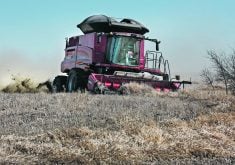The term “anaerobic digestion” was hanging around long before I chose to ignore it in my high school chemistry class.
I never paid much attention to it until recently when experts said phosphorous is the real environmental culprit on hog farms. ![]()
That’s when anaerobic biodigestion became relevant for chem-dummies like myself. I looked it up on the web and here’s what I found.
Anaerobic digestion falls into three general temperature categories: 5 to 25 C, 25 to 45 C and 45 to 60 C.
Read Also

VIDEO: Ag in Motion documentary launches second season
The second season of the the Western Producer’s documentary series about Ag in Motion launched Oct. 8.
Anaerobic digestion is a series of processes in which microorganisms break down biodegradable material in the absence of oxygen. A number of different microbes are needed. If any are missing, the process stops.
The process begins with bacterial hydrolysis of the input materials to break down insoluble organic polymers such as carbohydrates to make them available for the next army of bacteria in the lineup.
Acidogenic bacteria then convert sugars and amino acids into carbon dioxide, hydrogen, ammonia and organic acids.
Acetogenic bacteria convert these organic acids into acetic acid, along with additional ammonia, hydrogen, and carbon dioxide.
Methanogens then convert these products to methane and carbon dioxide.
The United Nations has recognized anaerobic digestion facilities as one of the most useful decentralized sources of energy because they are less capital intensive than large power plants.















